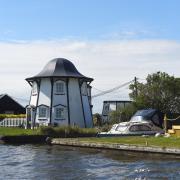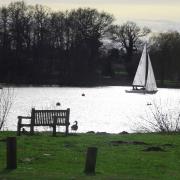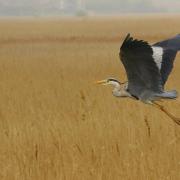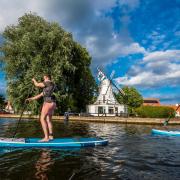Ever wondered about those millions of long shells on the beaches? Norfolk Wildlife Trust ambassador Nick Acheson explains their significance
On any of West Norfolk’s glorious sandy beaches, the strandline (left by the last high tide) is almost certain to hold razor shells. At times there can be millions of them, crunching loudly beneath your boots. We all know what they are - these brittle, yellowish-brownish shells which lie in lines along our beaches - but do we ever wonder who they were?
By this I mean, of course, the lives they lived, the conditions in which they lived them, and the dangers that they faced. As our boot soles crush their shells, do we even stop to think about the habitat from which these countless creatures came?
The basic facts are simple enough. Razor shells are molluscs and, within that mighty Phylum, they are bivalves. This means their shells are divided into two (usually symmetrical) halves, hinged together by a flexible ligament, so that the shell can open like a book.
Bivalves are hugely varied, even here in the UK. Mussels, for example, live in the open, anchoring themselves to underwater rocks, by means of doughty filaments known as byssus. Piddocks, by contrast, bore with tooth-like ridges on their shells into soft rocks, creating burrows in which, over time, the still-living animals become entombed.

Our razor shells live in-between lives, neither so exposed as mussels, nor so imprisoned as piddocks. Razor shells burrow vertically into coarse sand, but will emerge from their holes if conditions are no longer to their liking.
So far, so fascinating. But my point is neither about the taxonomy of shellfish, nor even about the quirky habits of piddocks and razor shells. My point is about our ignorance; our almost wilful blindness to the thousands of species which live around us, but out of sight.
If we’re honest, we know precious little about most species living right under our noses. The woodlouse blundering across the kitchen floor: do we really know where and how it lives. The skylark purring in the spring blue sky: do we know how badly its species has declined? The hairy bittercress growing in a pavement crack: have we even wondered how its flowers are pollinated.
With such mysteries literally within metres of us, it is understandable that we should know even less about the wildlife of the sea. Though a few hardy souls swim in the North’s Sea’s brooding water all year round, for most of us in Norfolk the sea is something we look at from the beach and maybe splash in once a year in sweaty August. Even Norfolk’s fishermen, who make their livings from the bounty of the sea, rarely see beneath its surface.
Land mammals as we are, evolved to walk and run and hunt in forest and grassland, we are essentially blind beneath the waves. Blind, deaf and mute. This makes it hard for us to understand the lives of marine organisms, at least without technology to aid us. Ignorance of these creature’s lives and habitats is understandable. But wilful devastation of them isn’t.
At this point, I have to bring you the news that we are not good neighbours to the sea. That’s an understatement: we are the proverbial neighbours from hell. But before we reflect on our own behaviour, let’s think about all the things the sea does for us, simply by existing.

A decade or so ago, I read a brilliant book called Sea Change by Norfolk author Richard Girling, in which he rightly says: ‘You can’t live in Britain and have no feeling for the sea. It is the amniotic fluid in which our civilization grew and was shaped.’
Girling goes on to list the ways in which the Atlantic, the Channel and our other waters have shaped society in the British Isles: ‘Our rim of salt has determined what we eat, how we use the land, how we relate to our neighbours, how and where we travel, even the thickness of our coats. Insulated by the Gulf Stream, our winters are 10 degrees warmer than Newfoundland’s. The sea is what gives us our cherished landscape of oak and beechwoods.
‘It’s why we’re so good at rain. It brought us the people - Romans, Vikings, Saxons, Normans - who filled our veins and shaped our culture, and kept out undesirables like Napoleon, Hitler and rabies.’
In return, what do we do? We spill oil in the sea and dump plastic in it, in terrifying quantities. We trawl the seabed, irrevocably damaging its benthic habitats. We overfish it, casually discarding tonnes of bycatch which can’t be sold. We overheat it with our carbon, turning it acidic. No, I regret, we are far from friendly neighbours to the sea.
At Norfolk Wildlife Trust we are interested in all wildlife; in thriving landscapes and seascapes; and in a healthy environment for all. We are committed to enhancing protection for the county’s marine habitats and biodiversity.
This commitment is enshrined in our new strategy, launched late last year, in which we set out our plans for restoring biodiversity and wild habitat in Norfolk and in the sea surrounding us.
Our work for the sea begins with awareness. For with awareness comes understanding. With understanding comes concern. And with concern comes action.
We need all of you - our readers, members, supporters, donors, friends and allies - to be advocates and ambassadors for the sea and its extraordinary wildlife.
So, the next time you’re walking on a Norfolk beach, and you hear the crunch of flimsy razor shells beneath your boots, look down. Wonder at the salty lives of the countless marine creatures that we barely notice. And make a pledge to join us in standing for their future.




























